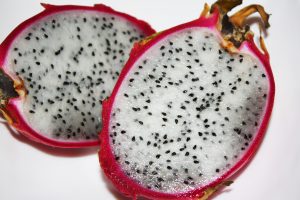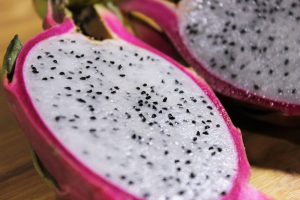
Dragon fruit is a unique and intriguing fruit that’s becoming increasingly popular all over the world. With its bright, striking colors, its tropical flavor and its array of health benefits, it’s easy to see why this fruit is gaining so much attention.
What is dragon fruit?
Dragon fruit, sometimes called pitaya or strawberry pear, is a tropical fruit native to Mexico, Central America and South America. It’s a type of cactus that grows on trees up to 10 meters tall and produces fragrant flowers. The fruit itself is oval or round in shape, with a tough, leathery, pinkish-red skin and green leaves. Inside the skin, the fruit is filled with edible white flesh and small, crunchy black seeds.
Nutritional Benefits of Dragon Fruit
Dragon fruit is an excellent source of dietary fiber, providing four grams per cup. Dietary fiber is important for promoting regularity and overall digestive health. The high fiber content in dragon fruit can also help keep cholesterol levels in check and promote heart health.
Dragon fruit is also a great source of vitamins and minerals. It is a good source of vitamin C, providing 21 percent of the daily recommended value in one cup. Vitamin C helps boost the immune system and protect the body from infection. Dragon fruit is also a good source of B vitamins, providing 10 percent of the daily recommended value in one cup. B vitamins are necessary for a variety of metabolic functions and help maintain healthy levels of energy. Dragon fruit is also a good source of magnesium and iron, which are essential for proper cellular function and energy production.
In addition to vitamins and minerals, dragon fruit is a great source of antioxidants. Antioxidants are compounds that help protect cells from damage caused by free radicals. Free radicals are unstable molecules that can damage cells and lead to a variety of chronic diseases. Eating foods rich in antioxidants can help protect the body from oxidative damage and reduce the risk of chronic disease. Dragon fruit is also a good source of lycopene, which is a carotenoid that helps protect against certain types of cancer.
Dragon fruit is low in calories and fat, making it an ideal food for weight loss. One cup of dragon fruit provides just sixty calories and less than one gram of fat. It is also a good source of protein, providing three grams per cup. Protein is important for maintaining muscle mass and promoting satiety, making it an ideal food for weight loss.
History of Dragon Fruit
Dragon fruit has a long and interesting history that dates back to the ancient Mayan civilization, where it was known as “huitlacoche” or “black corn.” It was believed to have medicinal properties and was often used in traditional medicine. The fruit was also a popular food source for the Aztecs, who used the flowers for religious ceremonies.
In the 17th century, the Spanish brought dragon fruit to Europe. It quickly became popular in the region, and was even mentioned in the writings of Francis Bacon. By the 19th century, it had spread to other parts of the world, including Southeast Asia, where it is still widely cultivated today.
Today, dragon fruit is widely available in many parts of the world. It is grown in tropical and subtropical climates, and can be found in markets, grocery stores, and online. While its exact origin is unknown, its popularity and health benefits have made it a beloved food for many cultures.
Cooking with Dragon Fruit
Dragon fruit, or Pitaya, is often overlooked in the kitchen. This beautiful, exotic fruit is believed to have originated in Central and South America, but is now found in tropical regions across the world. With its vibrant pink and green hue, it may look intimidating to cook with, but its sweet, mild flavor and unique texture make it a great addition to a wide range of dishes.
When selecting dragon fruit, it is important to look for bright, deep pink skin and firm flesh. Avoid any fruit with brown spots or bruises as this indicates it is overripe and not suitable for consumption. Before cooking, the fruit should be peeled and the seeds removed. The flesh of dragon fruit can then be cut into small pieces or grated to be used in various recipes.
Dragon fruit is a versatile ingredient and can be used in a variety of dishes. For a light and refreshing snack, try blending the fruit with yogurt, honey, and fresh fruit for a smoothie. The mild flavor of dragon fruit pairs well with other fruits, so you can create endless flavor combinations.
You can also use dragon fruit to make jam, sorbet, and popsicles. The sweet and tangy taste of dragon fruit makes it perfect for desserts and baking. When baking with dragon fruit, you can mix it with other fruits such as strawberries, mangoes, and apples for a unique flavor.
Dragon fruit can also be used in savory dishes. It pairs well with pork, chicken, and seafood. You can either stir-fry or bake the fruit with the chosen protein for a delicious meal. It is also great for adding to salads and salsa for a tasty side dish.
As you can see, dragon fruit is a great ingredient to have in your kitchen. It is packed with nutrients and has a mild, sweet flavor that pairs well with many dishes. From smoothies to savory dishes, dragon fruit is a versatile ingredient that can be used in a variety of recipes. So next time you’re in the grocery store, don’t forget to pick up a few dragon fruits and try cooking with them.

Clinical Trials on Dragon Fruit
The first clinical study to assess the potential health benefits of dragon fruit was conducted in 2011. This study looked at the effects of dragon fruit on cholesterol levels. The results showed that consuming dragon fruit daily was associated with an increase in HDL (good) cholesterol levels and a decrease in LDL (bad) cholesterol levels. This suggests that dragon fruit may be beneficial for reducing cardiovascular risk.
In 2012, another clinical trial was conducted to investigate the potential anticancer effects of dragon fruit. This study found that daily consumption of dragon fruit was associated with a reduction in the risk of developing certain types of cancer, including breast, colorectal, and prostate cancer. While more research is needed, these results suggest that dragon fruit may have potential to reduce the risk of certain types of cancer.
A third clinical trial conducted in 2013 looked at the effects of dragon fruit on diabetes. This study found that daily consumption of dragon fruit was associated with a decrease in blood sugar levels and an improvement in glycemic control. This suggests that dragon fruit may be beneficial for managing diabetes and improving overall health.
The most recent clinical trial to assess the potential health benefits of dragon fruit was conducted in 2016. This study looked at the effects of dragon fruit on the immune system. The results showed that daily consumption of dragon fruit was associated with an increase in the number of white blood cells, which helps to fight infection. This suggests that dragon fruit may be beneficial for boosting the immune system and fighting off illness.